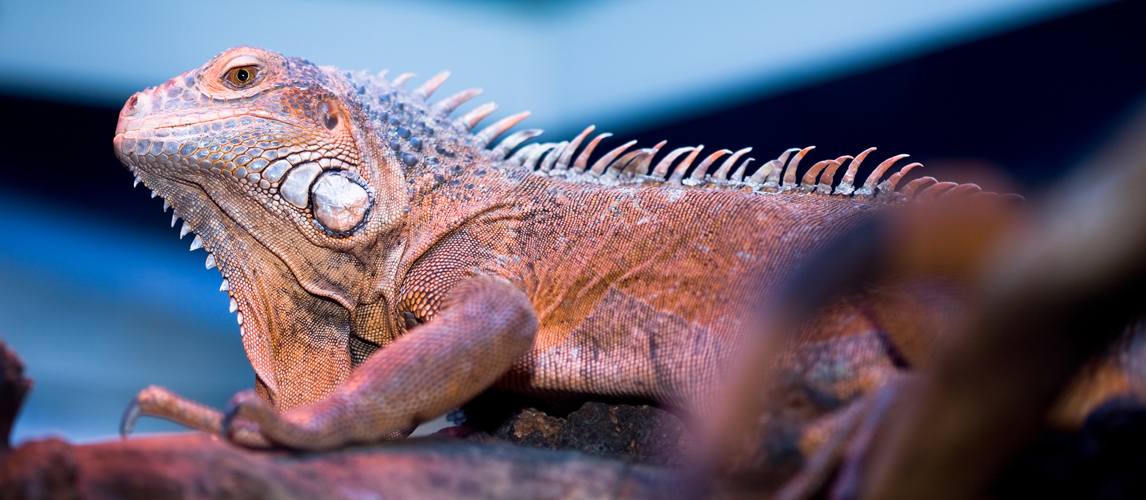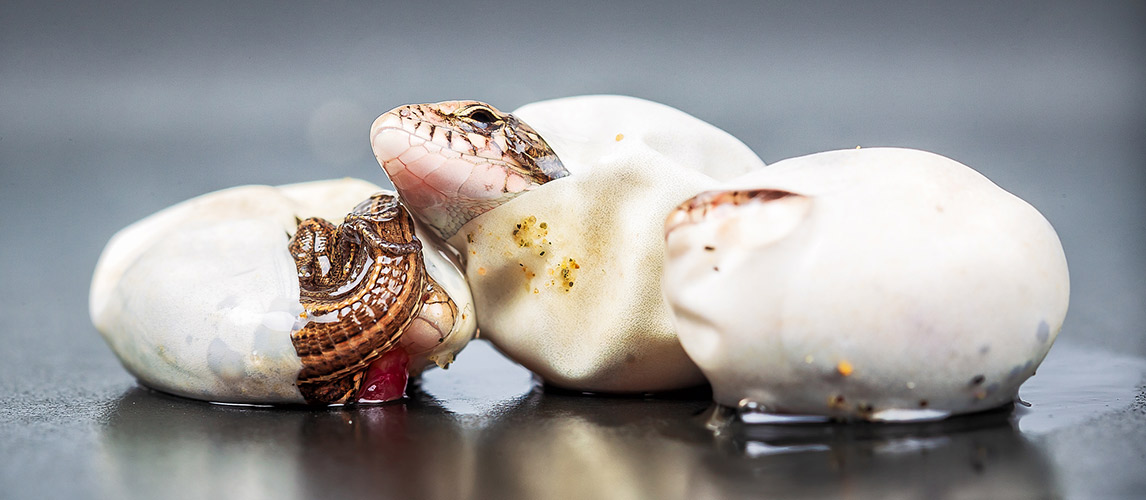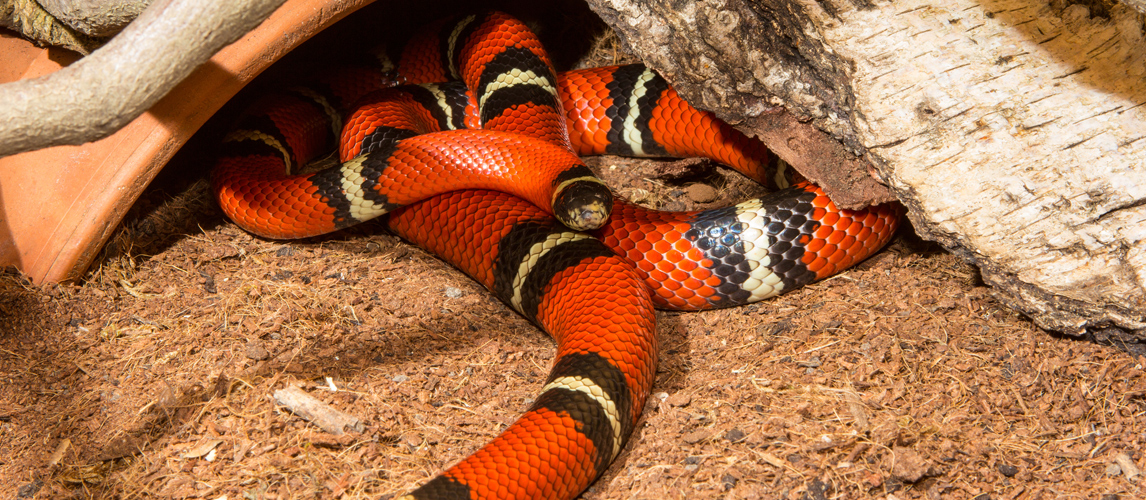
The Best Substrate for Bearded Dragons in 2022
- Home
- Other animals
- Reptiles
Substrate is the material that you place at the bottom of your Bearded Dragon terrarium. It makes the surface easier and more comfortable for your pet to walk on. It also gives them something interesting to interact with and can help to control humidity levels. Some substrates can even help to control odors which can be an important consideration. Choosing the right substrate is just as important as choosing the right food.
There are several different options that you can choose from. You have the option of a loose substrate or a carpet liner that you can cut to size. Each type of substrate has advantages and disadvantages so it is important that you choose one that suits your pet and the way in which you like to maintain the terrarium. To help you make the right choice, check out our guide to the best substrate for Bearded Dragons.
The Best Substrate for Bearded Dragons
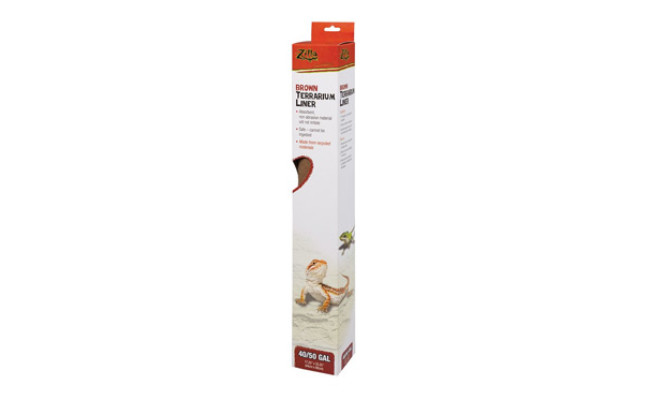
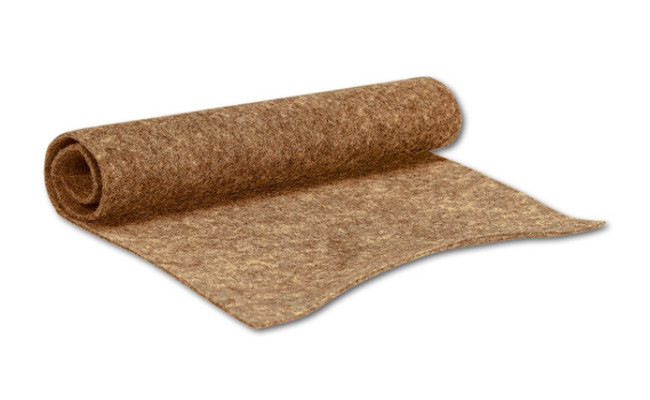


This great product is a terrarium liner made from a non-abrasive material that is also absorbent. It won’t irritate delicate reptile feet and helps to prevent unpleasant odors thanks to the biodegradable enzyme that has been used to treat it.
It is very easy to fit, all you have to do is roll it out and cut it to size. It is a very low maintenance bedding that makes your life easier. Once it is fitted, it looks like an attractive carpet surface in a green or brown color. When it needs cleaning, you just rinse it under cool tap water and put it back in. There is no risk of it being accidentally ingested as your reptile strikes for food because there is no loose bedding. This makes it highly suitable for juvenile reptiles. It has been certified by the United States Association of Reptile Keepers.
Fixed liner – no loose material
Trimmed to size and easy to fit
Non-abrasive and will not damage feet
Treated with biodegradable enzyme to control odors
- Brand: Zilla
- Model: 100111759
- Weight: 6.4 ounces
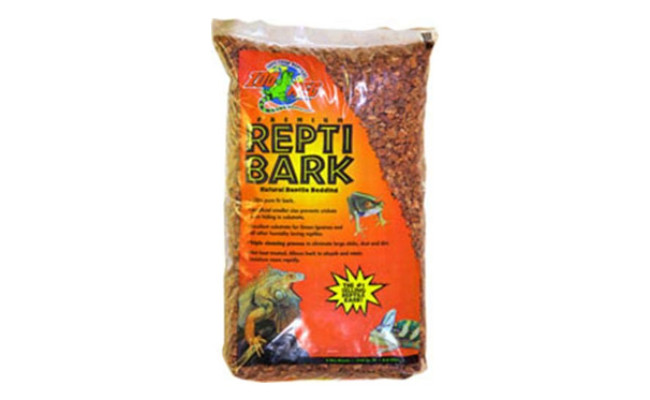
If you like the thought of a totally natural substrate for your Bearded Dragon, this is the product for you. It is made from the bark of fir trees and is hygroscopic. This is the scientific term for describing how it can absorb moisture but can also release it so it creates humidity within the terrarium. Because the chips are small, they have a large surface area and are therefore highly absorbent. Therefore, it is the perfect choice for reptiles that like a humid environment.
This substrate conducts and distributes heat evenly and provides a stimulating addition to your reptile’s environment. They can dig and burrow in it, just as they would in the wild. Because it is highly absorbent it sucks in waste and keeps it away from your pet. Plus, it looks great and gives a rainforest vibe to the terrarium. There is no waste because you can re-use it. Every two or three months, remove it and soak it in hot water to refresh it. You will only need to replace it once a year. The small pieces interlock and prevent live food in the terrarium from setting up home in the substrate!
Made from fir tree bark
Provides a stimulating environment
Can be reused for up to a year
Hygroscopic – produces a humid environment
- Brand: Zoo Med
- Model: RB24
- Weight: 2.27 pounds
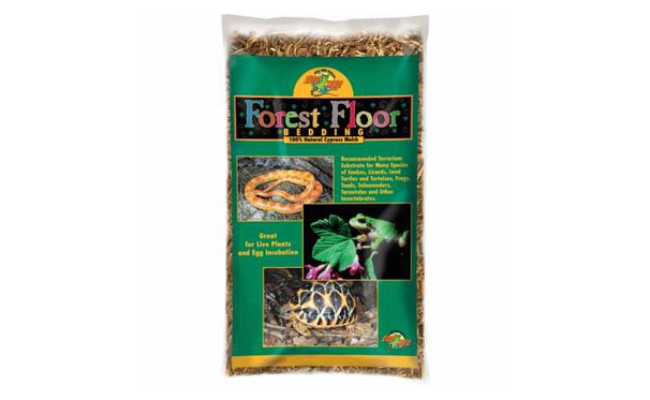
This natural floor bedding is soft and comfortable and highly absorbent. It is made from cypress mulch substrate. Your terrarium will have a natural “forest floor” look. This substrate is excellent at retaining moisture and will therefore create a lot of humidity within the enclosure.
It suits many different species of reptiles and amphibians. It will not stain your pet’s skin and does not encourage mold growth.
Soft and comfortable
Gives a ‘forest floor’ look
Creates high humidity
Made from cypress mulch
- Brand: Zoo Med
- Model: CM24
- Weight: 9 pounds
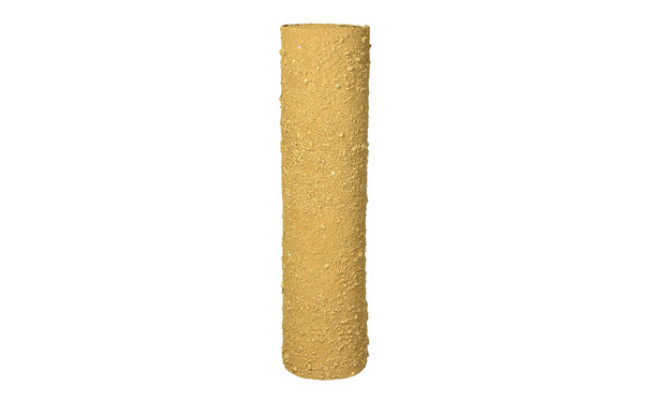
Here we have a sand mat that provides a terrarium substrate and gives the enclosure the feel of a desert environment. It is a safe and hygienic substrate that is suitable for many types of reptiles as it limits the amount of bacterial growth.
The full mat measures 47.5 inches by 17.5 inches but can be cut to the right size. It is very easy to put in and take out of the terrarium – it takes just a few seconds. When it gets dirty, you just rinse it in water and put it back in. There are no loose particles so there is no danger of it getting accidentally ingested. Your reptile will feel secure and safe as they travel across it because they can grip easily to the surface.
Sand mat gives a desert appearance
Can be cut to size
Rinse when it gets dirty
Cannot be accidentally ingested
- Brand: Exo Terra
- Model: PT2568
- Weight: 2.7 pounds
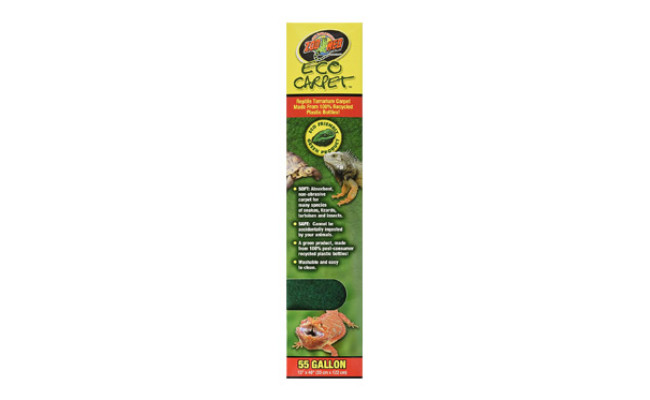
This is the ultimate in environmentally friendly products for your terrarium. It is a substrate carpet that fits in the bottom of the terrarium and is made entirely from recycled plastic bottles.
Because there are no loose particles in this Bearded Dragon carpet, there can be no accidental ingestion that could harm your pet. It is absorbent and completely safe to walk on. You can cut this sand mat for Bearded Dragon terrariums to fit your required size.
Environmentally friendly – made from recycled bottles
Substrate carpet
Absorbent and safe to walk on
Cannot be ingested
- Brand: Zoo Med
- Model: ET55
- Weight: 5.6 ounces
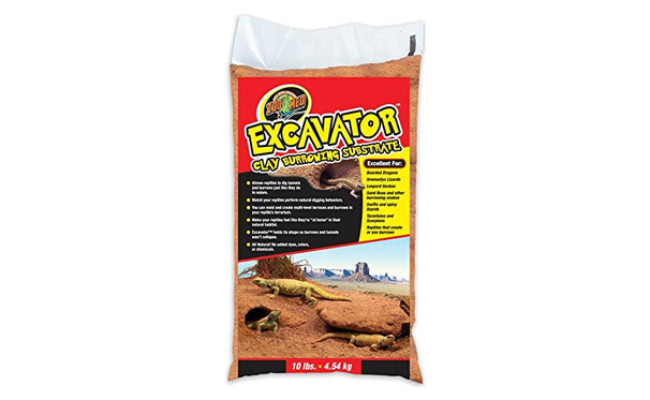
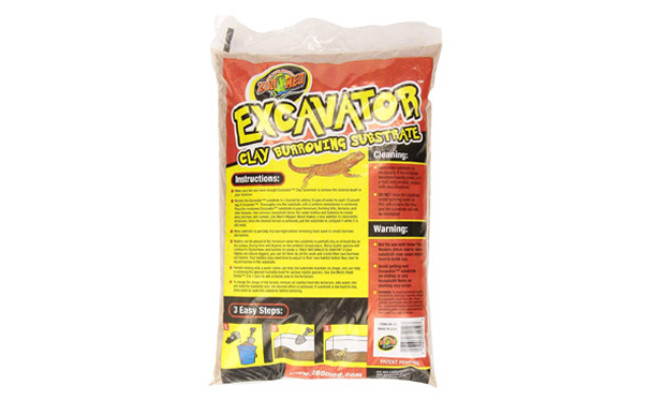


This loose clay substrate is great for animals that like burrowing because it maintains its shape. You add water to it before you put it in the terrarium. Then it will allow you to form hills and terraces. You can also use water bottles or balloons to create tunnels to make the habitat just like nature.
Some reptiles love to dig in it themselves but others just like to use the burrows that you have created. You have to periodically mist it with water to maintain the shapes. You can spot clean it as necessary by removing the soiled areas. It is a completely natural product and has no dyes or chemicals in it.
Loose clay substrate
Allows you to form hills and burrows
Contains no dyes or chemicals
Spot clean by removing soiled areas
- Brand: Zoo Med
- Model: XR10
- Weight: 1.44 ounces
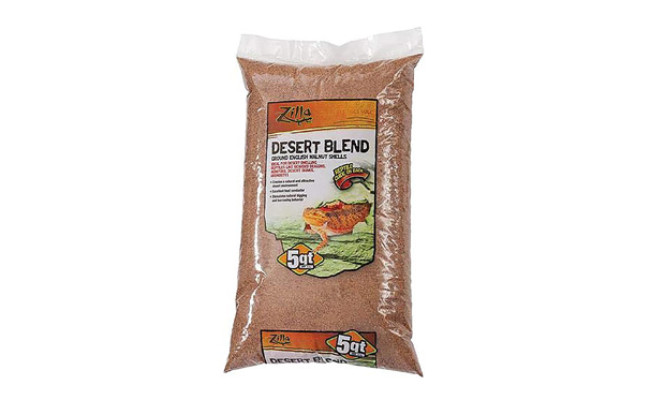
A fantastic, eco-friendly substrate that will appeal to the natural instincts of your bearded dragon. This substate stimulates the natural digging and burrowing behavior of your pets, while being made from completely natural resources. Namely, English walnut shells, which offer users a sustainable alternative to other substrates for bearded dragons.
Even better, this substrate won’t scratch the glass of your tank, while still offering ample heat conduction. As such, it replicates the natural environments of your bearded dragon, and ensure their health, happiness and wellbeing.
Stimulates natural digging and burrowing behavior
Made with natural resources
Won’t scratch tank glass
Replicates natural environments
- Brand: Zilla
- Model: 100111442
- Weight: 6.8 Pounds
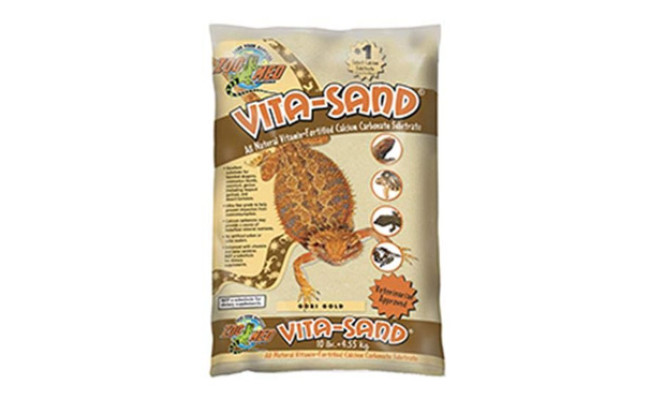
A completely natural substrate that consists of calcium carbonate that has been fortified with vitamins. There are no artificial color sealers or colors for you to worry about. It is perfect for your Bearded Dragon but will also suit Uromastyx Lizards and Monitors.
You can use this Bearded Dragon sand to increase calcium delivery and to top up your pet’s intake of vitamins and beta carotene. This promotes their overall health. There are no fat-soluble vitamins in this product as they have been known to be toxic to Bearded Dragons when ingested in large doses. It has an ultra-fine texture which stops over consumption.
Completely natural product
Contains calcium carbonate
Fortified with vitamins
Ultra-fine texture
- Brand: Zoo Med
- Model: VG10
- Weight: 9.92 pounds
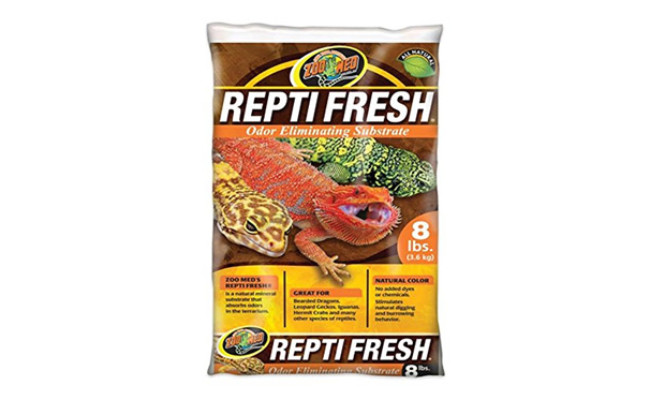
This is a long-lasting substrate which is perfect for owners who do not want to replace it very often. It has a natural color and has no added artificial colors or dyes. Thanks to its texture, it stimulates digging and burrowing.
This natural mineral substrate is perfect for Bearded Dragons as well as Leopard Geckos. All you have to do is pour it in to the bottom of your terrarium to a thickness of about two inches. You can remove the soiled sections using a scooper. However, you only have to replace the entire substrate every 12 months.
Long-lasting substrate – needs replacing once a year
You can pick out soiled parts with a spoon
Natural mineral material
No artificial colors
- Brand: Zoo Med
- Model: RO8
- Weight: 7.94 pounds
Best Bearded Dragon Substrate Buying Guide
Things to Consider When Buying a Bearded Dragon Bedding
There are plenty of substrates that you could choose for your Bearded Dragon terrarium. Here is a quick summary of what you should look for when you are buying some.
- Loose or carpet. Your first decision is whether to get loose substrate or a carpet. Loose substrate is closer to your pet’s natural habitat and they can make burrows in it. However, it does present a danger of compaction. Loose substrates may not be suitable for younger Bearded Dragons. Carpets can be cut to size but claws can get caught in them. You also have the option of using both!
- Safety. This is your primary concern. Make sure that you choose a substrate that is natural and does not contain any harmful dyes or colors.
- Cleaning. Again, this is a matter of personal preference. Carpets are easy to clean because you just wash them under running water and put them back in. You will need to remove solid waste from loose substrate with a spoon or scoop.
- Replacement. The more often you have to replace the substrate, the more expensive it will get. Think about how often you want to replace the whole substrate.
- Humidity. Humidity levels are important for Bearded Dragons. Choose a substrate that will help to control humidity levels. Some also help to dissipate heat.
- Odor control. Some substrates are treated with enzymes which helps with odor control. You may decide that this is an important feature for you.
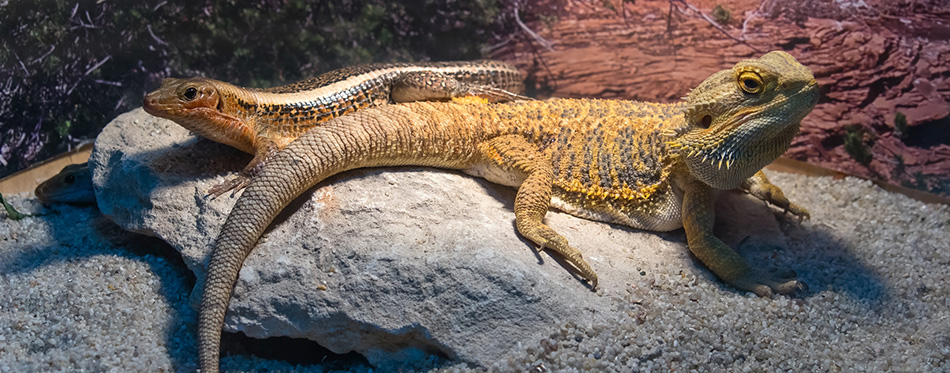
Why Do Bearded Dragons Need Substrate?
Terrarium substrate is the substance that is placed on the floor of your Bearded Dragon’s terrarium. It makes the enclosure look great and like your pet’s natural habitat but it also serves some other important purposes.
Without a substrate, your Bearded Dragon would have to walk on the glass bottom of the terrarium which they do not find very pleasant and is damaging for their delicate feet! They much prefer the feel of a substrate that mimics their natural environment and which helps to file their nails down.
It also helps with heat regulation. It can act a little like a heat sink and will trap excess heat when it is too hot and release it when the temperature drops. This helps to maintain a constant and healthy temperature for your Bearded Dragon. It does the same thing for humidity. You can soak the substrate and it will gradually give off water vapor and maintain a humid environment.
Substrate also provides something interesting for your pet to explore and helps to relieve boredom. Some substrates are treated with special enzymes so that can even help to control unpleasant odors in the terrarium.
Types of Bearded Dragon Substrate
There is no single perfect substrate for a Bearded Dragon terrarium. Reptile owners have very different opinions on what should be chosen and the online debates can get quite heated. It will eventually come down to personal preference, based on how much time you want to spend on cleaning and maintenance. The age of your Bearded Dragon is also an important consideration.
Here is a list of the potential substrates that you could choose for your Bearded Dragon terrarium.
- Sand and sand-like substrate
In their natural environment, Bearded Dragons spend their time walking across sand or small pebbles. Therefore, this may seem like the obvious choice for a Bearded Dragon terrarium substrate.
However, it is not without risks. Some owners are worried that sand substrate can present a risk of gut impaction for Bearded Dragons. Gut impaction is a medical condition where a blockage of the intestinal tract is caused by an object or by a number of objects that have been ingested. This is a very serious condition and can lead to death if immediate veterinary treatment is not sought.
The general consensus of opinion is that pebbles and gravel are not a suitable substrate for Bearded Dragons. If they are swallowed, they can certainly lead to impaction especially if the pebbles are small. They can also damage teeth. Bearded Dragons often accidentally ingest pebbles when they are aiming to eat an insect.
The advice regarding sand as a Bearded Dragon substrate is less clear. Many experts think that non-silica sands are safe to use and only present a small risk of impaction. However, they are not always suitable for young Bearded Dragons who are more likely to ingest it accidentally.
One way to overcome this problem is to use a calcium sand. The theory is that this calcium-based sand is metabolized by the body when it has been swallowed and is passed out of the body. However, some experts claim that even this can cause impaction.
- Reptile carpets
Terrarium carpets are also sometimes called cage liners. They are supplied as a roll and can be cut to size. Most are made out of a synthetic material and look like grass or the desert floor. They are very easy to fit because all you have to do is lay it on the floor so that it covers all of the glass. Because there is no loose material, the issues of accidental ingestion and gut compaction are avoided.
However, it is possible for the loops of the liner to get caught up in the claws of the Bearded Dragon. Often, the reptile will react by sharply pulling up their caught foot and this can cause the claw to be ripped off. This is painful and the wound can get infected. You can try to avoid this issue by choosing a liner with a tight weave.
- Newspaper lining/Paper Towels
This is the cheapest option for a Bearded Dragon bedding because you can use old newspapers and you don’t have to buy anything. There is no problem with impaction and there is nothing that claws can get stuck in. The downside is that they don’t look great and tend to make the terrarium look cheap and untidy.
You can get around this by choosing paper towels. This is a washed and shredded type of substrate that has been made from recycled newspaper. Bearded Dragons love to dig in it and this gives them something to do. This type of substrate will also retain moisture so there may be some issues with humidity.
- Bark and mulch lining
Bark and mulch can be successfully used for many pets but Bearded Dragons may not one of them! That is because they retain a lot of moisture.
You will probably find that the humidity levels rise too high to suit a Bearded Dragon but you may like to try this out for yourself.
- Ceramic tiles lining
Ceramic tiles are a fairly new product for terrariums but they are getting increasingly popular. You can use tiles that have been designed for bathrooms or kitchens.
They are very easy to clean and they look great at the bottom of the terrarium. There is no risk of impaction and they do not cause excessive humidity.
Tips for Using Bearded Dragon Bedding
It is worth taking the time to choose a substrate that suits both you and your pet. The aim is to get a substrate that will be safe, will be stimulating and that is easy to keep clean.
- Feeding on the substrate
In the wild, Bearded Dragons like to dig and burrow so a top tip is to choose a substrate that allows them to do that. It will provide plenty of engagement and fun for your reptile. However, there is the danger of your Bearded Dragon eating it and there are things that you can do to avoid that. Firstly, do not use a loose substrate for young Bearded Dragons as they are more likely to ingest it and their gut gets compacted more easily because it is smaller. Even with an adult reptile, you must be vigilant. Place the food in an area where there is no substrate or use a bowl so that your Bearded Dragon is not eating off the substrate.
- Cleaning the substrate
Some owners are willing to spend hours cleaning out the terrarium and others are not. If you are pressed for time, you need a substrate that is very easy to clean and change. You may find that a liner is best for you or you can use sand and remove the soiled parts with a scoop.
If you are willing to spend more time cleaning out the substrate, you could use a clay option. It will also give your pet something to build tunnels in and something to explore.
- Tips for loose substrate
Sand is a common loose substrate for Bearded Dragons but you will have to be vigilant. Do not use it for young reptiles because intestinal compaction is a real hazard if it is accidentally eaten. In fact, no type of loose substrate should be used for young Bearded Dragons.
If you do decide to use a sand substrate, choose one that will be soft on your pet’s feet. Playground sand and sand designed especially for terrariums are less dusty. It is possible to purchase sands that are designed to be ingested. They can be broken down by your pet’s body and passed out so they do not cause any problems. It is also possible to buy sand mixed with clean soil but you must make sure that the soil has not been treated with pesticides or fertilizers as these are harmful for Bearded Dragons.
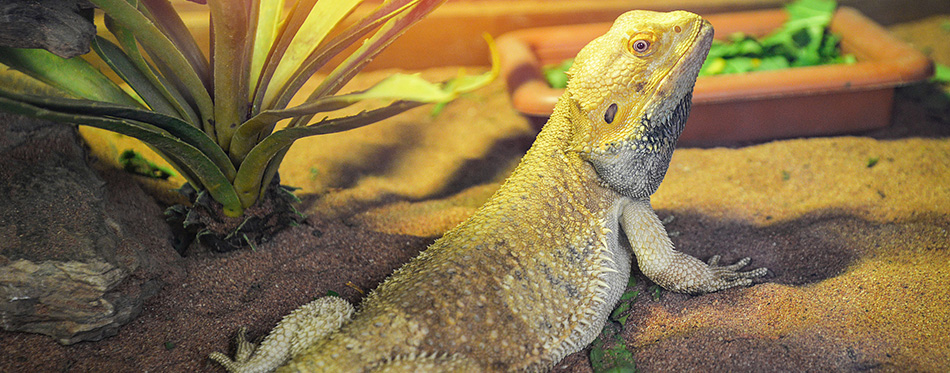
Our Top Pick
Our top pick of the best substrate for bearded dragons is a terrarium liner that is non-abrasive and very absorbent. There is a biodegradable enzyme which cuts down on odors.
To fit this Bearded Dragon substrate, all you have to do is roll it out and cut it to size. It has an attractive carpet appearance in green or brown. To clean it, you just rinse it under cool tap water. It cannot be accidentally ingested by your Bearded Dragon and is therefore perfectly safe. You can safely use it for juvenile reptiles and it is approved by the United States Association of Reptile Keepers.
Sources:
- Inland Bearded Dragon – Pogona vitticeps, PetMD
- Rick Axelson, DVM, Bearded Dragons – Housing, VCA Hospitals
Sharon is a Ph.D. scientist and experienced pet content writer. As a life-long animal lover, she now shares her family home with three rabbits, a Syrian hamster, and a Cockapoo puppy. She has a passion for researching accurate and credible information about pets and turning it into easy-to-understand articles that offer practical tips. When it comes to our furry friends, she knows that there is always something new to learn!
Related Posts


